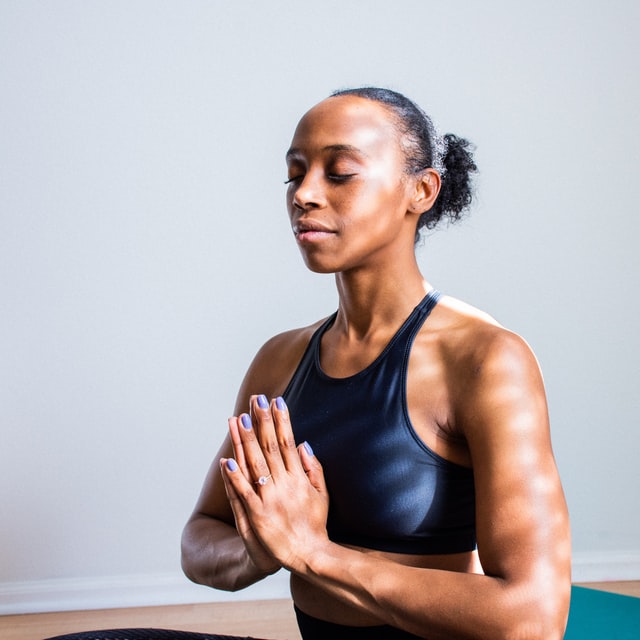Here’s a fact that may take your breath away: we take around 960 breaths per hour, 23 thousand breaths per day, and over eight million breaths per year.
The question is whether or not each of those breaths is conscious and controlled. Most of the time, our breathing is a fairly automatic, thoughtless process.
However, failing to show your breath some extra attention leads to shallow, fast, open-mouth breathing. This results in excess stress and anxiety.
The best way to combat the dangers of shallow breathing? Become mindful of your breath with controlled breathing exercises.
Controlled breathing not only prevents the dangers of unconscious breathing but also offers multiple advantages that will help you feel your best.
That’s why we’ve rounded up all of the best benefits of controlled breathing. First, let’s talk about what controlled breathing looks like…
Controlled Breathing, Explained
When you’re feeling short of breath, you aren’t getting enough air into your lungs.
Controlled breathing, sometimes called control pause breathing, helps you get as much air as possible into your lungs as quickly as possible.
The diaphragm muscles deep within the stomach activate with proper practice, unlike shallow chest breathing, which doesn’t allow for full use of all of the breathing muscles.

With this mindful breathing practice, your breathing slows, helping to calm both your brain and your body.
In fact, controlled breathing may even affect our emotions, which brings us to the first benefit of this method.
1. Influence Your Emotional State
Breathing has ancient Eastern roots that have long been correlated with calming the mind.
Meditation, yoga, Tai Chi, and other mindfulness exercises heavily rely on breathwork to lower anxiety.
That said, the mechanisms behind how and why this works were only recently discovered. In 2016, researchers stumbled upon a circuit within the brainstem that reacts to our breath rate.
This neutral circuit has been compared to a pacemaker, as activity in this area decreases during slow, controlled breathing and rises during fast, erratic breathing.
As a result, our emotional states respond. Faster breathing leads to the activation of our sympathetic nervous system, causing our stress responses to fire on all cylinders.

This stressful state leads to an increase in cortisol and adrenaline, which puts the cardiovascular system at risk over time.
Conversely, slow, controlled breaths take us out of a stressed state and place us into parasympathetic activation, which allows us to rest, digest, and heal.
Put simply, entering a restorative, calm state depends on the way we breathe!
Believe it or not, our emotional states and breathing patterns are also tied to our posture.
2. Better Posture and Reduced Back Pain
The connection between posture, breathing, and how we feel is a chain reaction.
Controlled diaphragmatic breathing activates the postural muscles that pull the “trunk” of our body upward, improving posture.
On the other hand, shallow, chest breathing requires the use of secondary muscles around the lungs and upper chest area, leading to poor posture.
Poor posture affects our health and worsens our breathing pattern, which then worsens our posture, and so on.
By practicing controlled breathing from deep within the diaphragm, posture improves.

As a result, back pain decreases, helping us to continue to breathe properly, and keeping us in a positive emotional state as we mentioned above.
So, if you’re looking to lose weight and reduce body fat, breathe easy… literally!
3. Boost Your Metabolism
It sounds too good to be true that breathing plays a role in our body composition and metabolism, but science backs up these claims!
Multiple studies support the idea that controlled breathing may aid in weight loss and lower body fat.
In fact, one small study found that people who practiced controlled diaphragmatic breathing had a higher resting metabolic rate, meaning they burned more calories after doing breathing exercises than they would have otherwise.
What’s more, participants in a separate study who practiced breathing exercises regularly over one month saw a significant reduction in body fat.
Researchers believe that this connection is caused by breathwork’s ability to regulate our nervous system and hormone secretion, which aids in weight loss efforts.
Controlled breathing may be your best line of defense for a boosted immune system, too.
4. Improved Immunity and Increased Lymphatic Drainage
What if keeping illness to a minimum relied on the way we breathe?
Some evidence suggests that controlled breathing boosts immunity thanks to its connection to our lymphatic system.
Lymph is a fluid packed full of infection-fighting white blood cells that protect us from illness.
Our lymphatic system is made up of tissues and organs that work together to remove toxins from the body by transporting lymph through the body.
Moreover, a slow breathing rate of 5.5 breaths per minute has been proven to improve the function of most bodily systems, placing the breath in sync with the rest of the body.

Airway health expert James Nestor referenced the immune-boosting powers of slow and steady nasal breathing in his book “Breath”.
This immune boost is thanks to nitric oxide, a miracle molecule released by the sinuses during nasal breathing.
“Immune function, weight, circulation, mood, and sexual function can all be heavily influenced by the amount of nitric oxide in the body,” Nestor writes.
Controlled nasal breathing also warms, filters, and humidifies our breath before it reaches the lungs, helping to decrease the number of pathogens and germs we inhale when compared to fast, shallow mouth breathing.
Beyond immunity, controlled breathing may assist in improving cognitive function and memory.
5. Superior Memory
In 2016, a study revealed that the rhythm of our breathing generates electrical activity within the brain. This brain activity affects how well we remember things.
Slow nasal breathing was found to improve cognitive function more than mouth breathing and also lead to an improved ability to remember certain objects.
When participants inhaled through the nose, they were able to recall fearful faces better than when inhaling through the mouth.
Scientists theorize that nasal inhalation lights up the amygdala, an area of the brain responsible for regulating emotion that is also linked to fear.
The hippocampus also lights up during nasal inhalation, which is at the heart of our learning and memory centers.
How to Practice Control Pause Breathing
Now that you know more about the amazing benefits of controlled breathing, you may be wondering how to put them into practice in your daily routine.
Begin by checking in with your diaphragm. Place one hand on your chest and the other hand on your abdomen.
If you cough, you should feel the diaphragm push out against your lower hand. Breathe in, causing the bottom hand to rise while your top hand remains still.
As you exhale, the bottom hand should rise while the top hand remains in the same position.
Once you’ve mastered diaphragmatic breathing, try Buteyko control pause breathing.
Buteyko control pause breathing was created in the 1950s by a Ukrainian doctor named Konstantin Buteyko.
It’s known to improve breath awareness, help decongest the nose to encourage nostril breathing, and prevent over-breathing through the mouth.
@somnifix Dr. Buteyko is known for control pause breathing, but did you know his backstory? @Breathe explains! #buteykomethod #oxygenadvantage #breathwork #asthma #breathingexercises #learnontiktok ♬ Running Up That Hill (A Deal With God) [2018 Remaster] - Kate Bush
Buteyko control pause breathing is also known to promote deep sleep, making it easy to incorporate into your everyday life by practicing this method right before bed.
To practice control pause breathing:
- Sit on a chair or the floor with an elongated spine
- Relax your breathing muscles by breathing normally in and out of the nose for several minutes
- Breathe in through your nose, then out through the nose, and hold your breath
- Use your index finger and thumb to plug your nose
- Move your head up and down until you feel a large hunger for air, which may include a small movement of your diaphragm
- Inhale through the nose, then begin to breathe normally in and out of the nose for at least ten seconds
- Repeat this cycle several times as needed
Now that you know how to put Buteyko control pause breathing into practice each day, you’ll begin to notice improvements in your wellbeing and breathing rates.
Nevertheless, you may still be breathing dysfunctionally during sleep.
Practice Slow, Controlled Breathing at Night
If you’re not breathing slow and steady as you sleep, your airway may become obstructed, causing snoring and disrupted sleep.
You’ll place your body in a dysfunctional state if you’re mouth breathing as you rest. That said, you can’t exactly practice Buteyko control pause breathing while you’re asleep, even if you dream about it.
The easiest way to continue breathing efficiently as you rest? Physically seal your lips shut with mouth tape!

Mouth tape is known to help users nasal breathe all night long, prevent snoring, improve breathing quality, and aid in sleep quality every hour of the night.
Simply pop a SomniFix Mouth Strip on your lips before bed and drift off into controlled breath as you sleep – all without you having to do a thing!
Better yet, rest assured that our Strips are free from allergens such as latex and gluten. Our gel-like adhesive is non-irritating and comfortable, so you won’t feel like you’re wearing anything on your lips at all.
Our Strips also feature a small breathing vent that allows for mouth breathing in emergencies such as sudden overnight congestion.
Improve your overall health as you sleep with SomniFix – don’t let your head hit the pillow without it!



